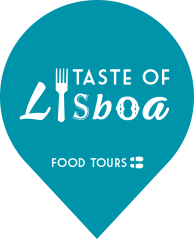Travel around Portugal in 18 Foods (without leaving Lisbon)

Taste of Lisboa’s food & cultural experiences take place mostly in our capital city. That doesn’t mean that, in here, we don’t get to enjoy food and drinks from all over the country. In Lisbon it’s fairly easy to come by dishes from different corners of Portugal. Yet, to try specific regional recipes, it is often required to, if not travel to those regions, at least seek specialized restaurants.
To demystify the idea that Portuguese cuisine is little more than pastel de nata, codfish, sardines and Port wine, today we take you on a delicious voyage around our country. Right now we focus on mainland Portugal, leaving the cuisine of our islands for a separate delectable journey.
18 districts. 18 foods. Here we go!
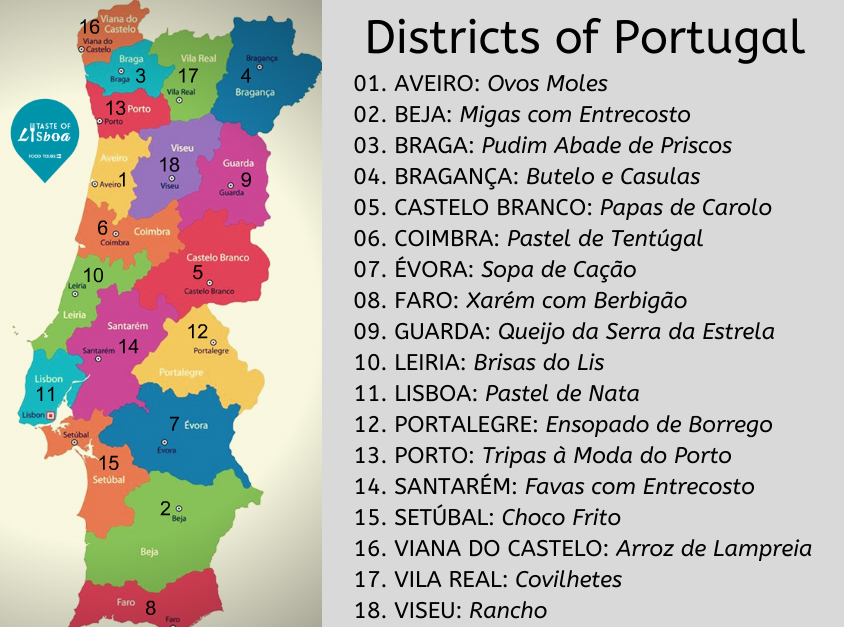
1. Aveiro: Ovos Moles
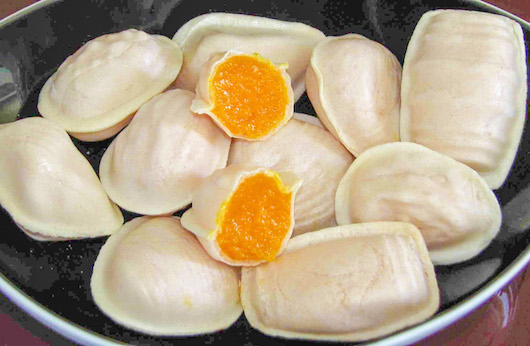
We start this culinary trip on a sweet note. A very sweet note! Ask any Portuguese person and they’ll mostly agree that one must not travel to Aveiro and skip tasting the eggy delight that is Ovos Moles. Soft eggs, as the name of this sweet translates, consist in thick egg jam which you can eat with a spoon or, most commonly, wrapped inside thin wafers shaped as sea inspired motifs. This egg yolk and sugar speciality dates back to the 19th century, and it is so representative in our country that it actually has Protected Geographical Indication (IGP) by the European Union.
Where to eat Ovos Moles in Lisbon:
Pastelaria Alcôa
Rua Garrett 37 – Neighborhood: Chiado
2. Beja: Migas com Entrecosto

This is one of the most popular dishes of Alentejo’s cuisine. Migas, a savory pudding that consists of fried bread crumbs with pork drippings and seasonings such as garlic and cilantro, is in this case served alongside fried ribs. Food from Alentejo, where Beja is located, is well-known for its many uses of bread, and migas is just one example of what you can do with rustic bread when it’s no longer soft to be eaten as it is. Here we’re talking heavy comfort food, ideal for winter but, let’s face it, we enjoy it all year round!
Where to eat Migas com Entrecosto in Lisbon:
Casa do Alentejo
Rua das Portas de Santo Antão 58 – Neighborhood: Baixa
3. Braga: Pudim Abade de Priscos
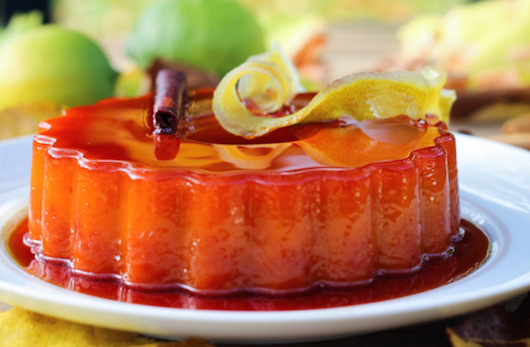
Quite likely the most sinful of all Portuguese desserts, this pudding was named after its creator, the Priscos abbot, a religious figure during the 19th century in the city of Braga. Unlike most Portuguese puddings, made with milk or butter, this dessert replaces dairy with pork lard, responsible for its smooth consistency. In English, this sweet sin is often referred to as bacon pudding, as bacon (mostly the white fatty part) is indeed part of the recipe – but note that we’re not talking about smoked bacon, that would overpower the flavor of eggs and the generous amounts of caramel well-known in the Portuguese pudding repertoire!
Where to eat Pudim Abade de Priscos in Lisbon:
JNcQUOI
Avenida da Liberdade 182 184 – Neighborhood: Baixa
4. Bragança: Butelo e Casulas

Unlike the foods previously mentioned, this is not a very well-known dish, not even among Portuguese people. But in the region of Trás-os-Montes, where Bragança is located, there’s even a gastronomic festival entirely dedicated to keeping the tradition of Butelo e Casulas alive! Butelo is a typical way of preserving meat, that clearly embodies the spirit of avoiding food waste characteristic to a lot of Portuguese sausage-like creations. Butelo is pork intestine stuffed with small pieces of meat and bones, seasoned with garlic. After cured and smoked, Butelo is eaten boiled, paired with beans and casulas, that is, the actual bean pods that are cooked until tender.
Where to eat Butelo e Casulas in Lisbon:
Sorry, for this one you really have to travel to Trás-os-Montes!
To enjoy other dishes from this region in Lisbon, visit À Justa by Chef Justa Nobre, at Calçada da Ajuda 107 – Neighborhood: Ajuda
5. Castelo Branco: Papas de Carolo
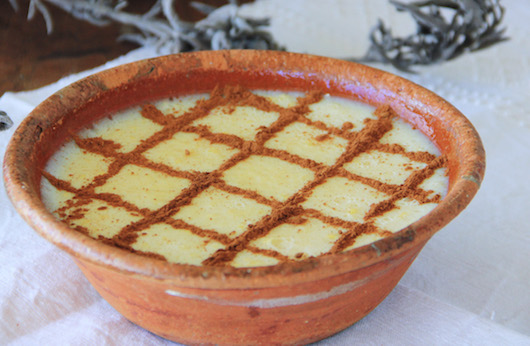
At a first glance, one can barely tell the difference between Papas de Carolo and sweet rice pudding, known in Portugal as Arroz Doce. This sweet dish is much harder to come by than the ubiquitous rice recipe though. Papas de Carolo are a home treat cooked particularly in the Beiras region of Portugal, where the city and district of Castelo Branco are located. It consists of a porridge-like concoction made with sweetened milk and corn semolina, known in Portuguese as carolo. In good Portuguese fashion, this smooth dessert is dusted with cinnamon, often used to make decorative patterns on the top layer of the Papas de Carolo.
Where to eat Papas de Carolo in Lisbon:
Make friends from the Beiras region and ask them to cook Papas de Carolo for you – this is a home treat!
6. Coimbra: Pastel de Tentúgal

Pastel de Tentúgal is an almost impossibly thin and flaky pastry. For real! If you see this video of how the dough for it is made, covering several metres of surface, you will know exactly how this impressive consistency is achieved. Pastéis de Tentúgal are delicate pockets of ultra thin pastry similar to filo, filled with luscious egg jam. These pastries were created by the carmelite nuns of Tentúgal and are therefore considered an example of great Poruguese conventual pastry making. Pastéis de Tentúgal are dusted with confectioners sugar for an elegant finishing touch.
Where to eat Pastel de Tentúgal in Lisbon:
A Pousadinha
Rua de São Paulo 188 – Neighborhood: Cais do Sodré
7. Évora: Sopa de Cação

The world of fish and seafood around Portugal is truly vast. In the Alentejo, one of the Portuguese regions best known for its quality food, Sopa de Cação is famous and for good reason. As many beloved foods from this part of the country, the recipe behind it is not too complicated. Think of a thick broth infused with garlic and cilantro, and thin slices of dogfish shark, seasoned with a splash of vinegar. Traditionally served over slices of bread, this dish typical from around Évora, is Alentejo comfort food at its best!
Where to eat Sopa de Cação in Lisbon:
O Magano
Rua Tomás da Anunciação 52A – Neighborhood: Campo de Ourique
8. Faro: Xarém com Berbigão

If you travel to the South of Portugal, the Algarve, you will easily come across similarities between this region and the north of Africa. Xarém is a typical food from this area, as well as countries where the Portuguese have had a historical influence – mainly Cape Verde and Brazil. It consists of a corn flour stew with porridge consistency, an ingredient that in Portugal is mostly reserved for bread making. As the Algarve is a not too thick strip of land by the ocean, it’s only normal that fish and seafood play an important role in the local diet. That is why Xarém is normally served with cockles.
Where to eat Xarém com Berbigão in Lisbon:
O Frade
Calçada da Ajuda 14 – Neighborhood: Belém
9. Guarda: Queijo da Serra da Estrela

Behold the most iconic of Portuguese cheeses! Hailing from the valleys around Serra da Estrela, where the highest peak of mainland Portugal is located, this is the type of product cheese lovers into bold flavors will appreciate. Buttery, intense and long-lasting. As Serra da Estrela cheese has been granted PDO status in the European Union, its production is limited to specific geographical areas. Things are strict when it comes to the milk proper for its making too! Only local breeds of sheep are used, and their milk is curdled with an ancient method that takes thirtle flower, following an 8 century long tradition. Serra da Estrela cheese can be eaten after about 60 days of its production, or cured until it becomes more ripe. When it’s young, this extremely unctuous cheese can’t even be sliced. Instead, the modus operandi involves cutting off the top layer of the crust so that you can scoop away!
Where to eat Serra da Estrela cheese in Lisbon:
Manteigaria Silva
Rua Dom Antão De Almada 1 C/D – Neighborhood: Baixa
10. Leiria: Brisas do Lis

If we could appoint an edible ambassador to the district of Leiria, Brisas do Lis would be it! These fine confections take only 3 ingredients – egg yolks, sugar and ground almonds – but make the delights of folks with an acute sweet tooth. Yet another beautiful example of Portuguese conventual pastry, Brisas do Lis were created by the resident nuns of Santana convent in Leiria. When you think about egg yolk based Portuguese desserts, it’s hard to imagine how recipes that take mostly the same ingredients, end up being so different in terms of taste and texture. This is something you can easily keep yourself entertained with as you travel around Portugal: try conventual pastries from around the country, which you can even purchase in Lisbon itself, and decide which one is your favorite!
Where to eat Brisas do Lis in Lisbon:
Casa dos Ovos Moles em Lisboa
Calçada do Sacramento, 25 – Neighborhood: Chiado
11. Lisboa: Pastel de Nata
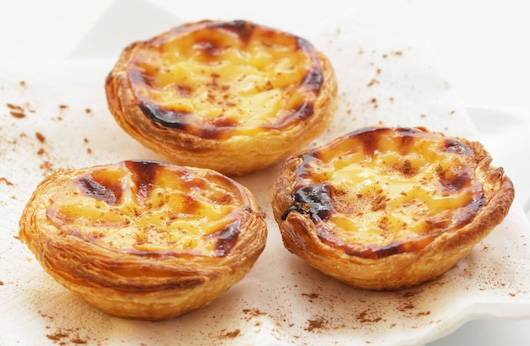
No other treat could represent the district of Lisbon better than the uber famous Pastel de Nata. No longer known as “custard tart” all that much, the fact that foreigners are now-a-days referring to the most representative of Portuguese pastries by its own name in Portuguese, is a good sign of how Pastel de Nata has archived the international status it deserves. Flaky layers of puff pastry that sweetly embrace the smoothest of custards, with a hint of lemon or not depending on the baker’s preference, finished off with a generous dusting of powdered cinnamon. Rember: if you eat Pastel de Nata at Antiga Confeitaria de Belém, in the Belém neighborhood of Lisbon, the pastry would be called Pastel de Belém. Everywhere else, it’s called Pastel de Nata. Trademark issues aside, the recipe is remarkably similar and it’s a thing to do going around Lisbon trying different ones. By the end of your trip in Portugal, you should be able to at least name your top 3!
Where to eat Pastel de Nata in Lisbon:
Along our Lisbon Market, Food and Cultural Walk we share with you our favorite Pastel de Nata in Lisbon. We’re pretty sure you are going to love it! – Neighborhoods: Mouraria, Baixa, Campo de Ourique
12. Portalegre: Ensopado de Borrego
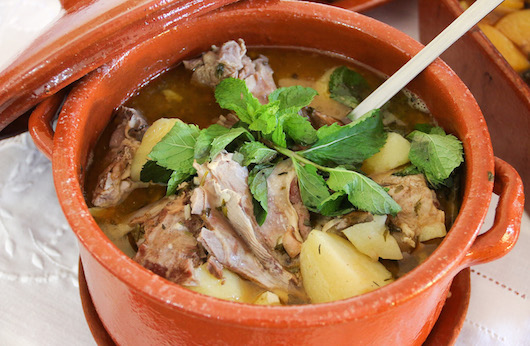
While pork is king when it comes to meat based dishes in our country, you will certainly be able to find recipes involving other meats, both in Lisbon and all around Portugal. In Portalegre, Ensopado de Borrego is a hearty lamb stew that will ensure you pack up enough heat and calories to keep exploring. The saucy recipe is served over bread, explaining the name of the dish: ensopado means “soaked”, and the slices of bread will indeed become soft with the juicy meat gravy poured on top. This is old-school food, messy and delicious!
Where to eat Ensopado de Borrego in Lisbon:
Zé Varunca
Travessa das Mercês 16 – Neighborhood: Bairro Alto
13. Porto: Tripas à Moda do Porto

Many think Francesinha is the most representative dish around Porto. This may be true these days, as far as pop culture goes. But Tripas à Moda do Porto goes way, way back! Ask locals and they will confirm that this is the dish of Porto. No wonder Porto locals are jokingly referred to by the rest of the country as tripeiros, that is, tripe eaters! This tripe stew is a testament to the hardships the people of Porto once had to endure. When about 500 years ago Portuguese sailors started exploring different corners of the world, they departed from Porto. As the best ingredients were packed in the ships to feed the crew that was off on an adventure of a lifetime, the residents were left with not much more than scraps. Trimmings and fatty bits came together with creativity, and so the recipe for Tripas à Moda do Porto was born!
Where to eat Tripas in Lisbon:
Tasca do Gordo
Rua Cordoeiros a Pedrouços 33 – Neighborhood: Belém
14. Santarém: Favas com Entrecosto

Analyzing the repertoire of traditional Portuguese cookery, you will easily notice that, historically, our country’s cooking style has relied a lot on stews. Big families meant big pots, where a few seasonal ingredients thrown in together with the right seasonings and lots of love, would result in exquisite food. Favas com Entrecosto features fava beans and short ribs, in a combination of earthy and salty, saucy and filling. Variations of this dish may replace the entrecosto, short ribs, for chouriço. Portuguese people will easily remember local singer’s José Cid’s song “A pouco e pouco”, where he lovingly sings to his wife, asking her to make him this fava dish!
Where to eat Favas com Entrecosto in Lisbon:
O Cardoso da Estrela D’Ouro (only on wednesdays)
Rua da Graça 22 – Neighborhood: Graça
15. Setúbal: Choco Frito
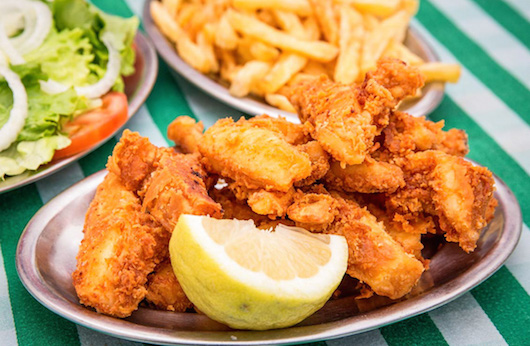
When you travel to Lisbon, a day trip to the nearby port city of Setúbal is well worth your while. If nothing else, at least to eat Choco Frito. Not that Setúbal doesn’t have a lot of things to see and do, it does, but this fried cuttlefish dish justifies the trip alone! If you like squid, you will love cuttlefish. Similar flavor, yet chunkier, thicker meat, perfect for battering and deep-frying. Squeeze a little lemon to cut the fat before you dig in and voilà! Fried cuttlefish is normally served with fries and salad, and it is one of the most unanimously approved seafood dishes you can enjoy around Lisbon. Some like fish stews, others prefer grilled fish. But everyone digs a crunchy serving of Choco Frito!
Where to eat Choco Frito in Lisbon:
Hop on the train and, in just about 40 minutes, you will be in Setúbal. Once in this coastal city the question will be where not to eat Choco Frito!
Not enough time to leave Lisbon? Go then to Choco do Bairro
Rua Ten. Ferreira Durão 55 A – Neighborhood: Campo de Ourique
16. Viana do Castelo: Arroz de Lampreia

The snake looking river fish lamprey is a very seasonal food and, because of this and its flavor, it’s a true delicacy, particularly in the north of the country. Considered by many foreigners a fine example of Portuguese bizarre food, lamprey is a blood sucking animal that ironically is usually cooked in its own blood. Arroz de Lampreia, that is, lamprey rice, is a saucy risotto of pieces of lamprey in “its own juices”. Fresh lamprey is only available from January through April. If you’re in Portugal around the beginning of the year, make the most of the opportunity!
Where to eat Arroz de Lampreia in Lisbon:
Solar dos Nunes (when in season)
R. dos Lusíadas 68 – Neighborhood: Alcântara
17. Vila Real: Covilhetes
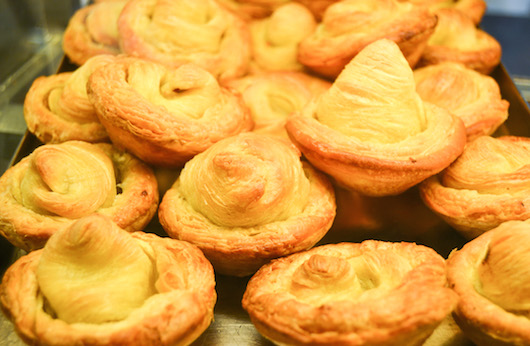
Those who like puff pastry and ground meat are in for a real treat! This gastronomic icon from around Vila Real, is always available in bakeries around the capital of Trás-os-Montes, but unfortunately it’s not too easy to come by elsewhere around Portugal. Covilhetes consist of a cup shaped base of puff pastry, similar to a pastel de nata. They are stuffed with wine and spices marinated minced beef, and covered with a little pastry hat that prevents the meat from drying as these savory pies are baked.
Where to eat Covilhetes in Lisbon:
Prazeres da Terra
Largo Dona Estefânia 6 – Neighborhood: Saldanha
18. Viseu: Rancho

In the interior of Portugal, where temperatures during winter drop below zero, filling stews are the way to go! Rancho is a boiled dish that includes vegetables like cabbage, potatoes and carrots, cuts of meat such as chorizo, blood sausage and bacon, chickpeas, and small shapes of pasta. The water where all the ingredients are boiled eventually turns into a broth with the depth of all the flavors thrown in the mix combined. Somewhere between a rich soup and stew, Rancho is unmissable when in Viseu and around!
Where to eat Rancho in Lisbon:
Restaurante Toledo (on Thursdays)
Rua Alexandre Ferreira, 34-A – Neighborhood: Lumiar
Food tells the story of a country and its people.
Immerse yourself in the Portuguese food and culture by joining one of our natively curated food & cultural experiences in Lisbon!
Feed your curiosity on Portuguese food culture:
The biggest misconceptions about Portuguese food
7 tidbits you want to taste in Lisbon
Lisbon and its sustainable way of living
Real people, real food. Come with us to where the locals go.
Signup for Taste of Lisboa’s next natively curated food & cultural experience.
Follow us for more at Instagram, Twitter e Youtube
